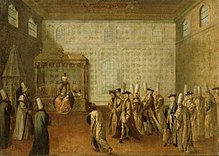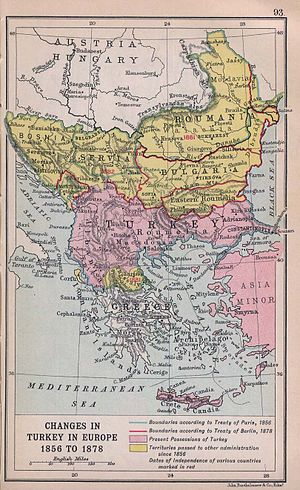Foreign relations of the Ottoman Empire
[18] Mehmed the Conqueror (1444–1446, and 1451–1481) scored the most famous victory in Ottoman history when his army finally on 29 May 1453, captured Constantinople and brought an end to the Byzantine Empire.
Selim I moved south and took control of Mecca and the West Arabian Coast, suppressed revolts in Anatolia and Syria, and formed an alliance with Algiers.
[27] Humayun maintained a cordial relationship with Suleiman the Magnificent and handed him a letter through the shipwrecked Ottoman admiral Sidi Ali Reis, who acted as an intermediary [28].
Akbar often sent political adversaries to Mecca for the hajj, but his initial conflict with the Ottomans happened due to members of his household being mistreated there.
This could also be because Akbar became really interested in syncretic religions at this time, eventually leading to his creation of Din-i Ilahi, which combined Hinduism, Islam, and Christianity.
The Portuguese were always interested in controlling the trade routes of the region, especially Aden, which lay on the crucial Bab el-Mandeb strait linking the Red Sea to the Indian Ocean.
Tensions arose when Shah Jahan conquered Kandahar from the Safavids, as the Ottomans feared that the Mughals were expanding too far westwards and would eventually reach their own lands [33].
Aurangzeb did not attempt to maintain significant relations with the Ottomans as under his reign, Maratha power was curtailed and most of India was under his rule, making it unnecessary for him to need foreign aid.
[40] According to John Norton, additional weaknesses of Suleiman included his conscription of Christian children, maltreatment of subject peoples, and obsession with his own prestige.
[43][44] A 16th century Chinese gazetteer, Shaanxi tongzhi, claims that there were Han-Chinese people living in a number of Ottoman controlled towns and cities such as Beirut, Tartus, Konya, and Istanbul.
[46] Some of these missions may have been from Uzbekistan, Moghulistan, or Kara Del because the Ottomans were known in China as the rulers of five realms: Turfan, Samarqand, Mecca, Rum and Hami.
The Inner Eurasian Muslim khanates of Kazan, Khwarazm, and Bukhara were wary of Russian expansion and looked to the Ottomans for the maintenance of Silk Road contacts.
Nonetheless, the Russians agreed to grant Central Asian Muslim pilgrims safe passage into Ottoman territories after the First Russo-Turkish War.
In 1679–1680, the Russians repelled the attacks of the Crimean Tatars and signed the Bakhchisaray Peace Treaty on 3 January 1681, which would establish the Russo-Ottoman border by the Dnieper.
[51] The coalition was organized by Pope Innocent XI and included the Papal States, the Holy Roman Empire under Habsburg Emperor Leopold I, the Polish–Lithuanian Commonwealth of John III Sobieski, and the Venetian Republic; Russia joined the League in 1686.
The Ottoman formed an alliance with the Polish opposition forces of the Bar Confederation, while Russia was supported by Great Britain, which offered naval advisers to the Imperial Russian Navy.
He was then transferred to the Ottoman theatre of operations, where in 1773 and 1774 he won several minor and major battles following the previous grand successes of the Russian Field-Marshal Pyotr Rumyantsev at Larga and Kagula.
[58] On 21 July 1774, the defeated Ottomans signed the Treaty of Küçük Kaynarca, which formally granted independence to the Crimean Khanate; in reality it became dependent on Russia.
[60] As the 19th century progressed, the Ottoman Empire grew weaker and the United Kingdom increasingly became its protector, even fighting together in the Crimean War during the 1850s against the Russians.
Although distressed by the establishment of the republic in France, Ottoman government was soothed by French representatives in Constantinople who maintained the goodwill of various influential personages.
For decades a sultan's word had had no power in outlying provinces, prompting Selim's reforms of the military in order to reimpose central control.
One rebellious leader was Austrian-backed Osman Pazvantoğlu, whose invasion of Wallachia in 1801 inspired Russian intervention, resulting in greater autonomy for the Dunubian provinces.
In 1814, a secret organization called Filiki Eteria (Society of Friends) was founded with the aim of liberating Greece, encouraged by the revolutionary fervor gripping Europe in that period.
The Ottoman Sultan called in Muhammad Ali of Egypt, who sent his son Ibrahim Pasha to Greece with an army to suppress the revolt in return for territorial gains.
Further negotiations in 1832 led to the London Conference and the Treaty of Constantinople; these defined the final borders of the new state and established Prince Otto of Bavaria as the first king of Greece.
[77] Economic stagnation prevailed in Ottoman lands areas in the 1840s and 1850s at a time when rapid industrialization characterized Britain and Western Europe—areas that also expanded their commerce in the Levant.
This opened the way for Napoleon III in France and Otto von Bismarck in Prussia to launch a series of wars in the 1860s that reshaped Europe.
Additional factors included Russian goals of recovering territorial losses endured during the Crimean War of 1853–56, re-establishing itself in the Black Sea and supporting the political movement attempting to free Balkan nations from the Ottoman Empire.
Despite memories of the terrible defeat at Mohács in 1526, elite Hungarian attitudes were become strongly anti-Russian This led to active support for the Ottomans in the media, but only in a peaceful way, since the foreign policy of the Austro-Hungarian monarchy remained neutral.
According to Kemal Karpat: This decision ultimately led to the deaths of hundreds of thousands of Ottomans, the Armenian genocide, the dissolution of the empire, and the abolition of the Islamic Caliphate.






